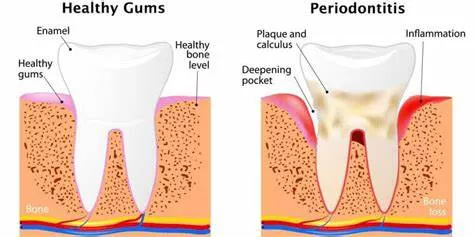Periodontal disease, commonly known as gum disease, is a prevalent oral health issue that affects millions of people worldwide. It ranges from simple gum inflammation to serious disease that results in major damage to the soft tissue and bone supporting the teeth. In severe cases, teeth may be lost. This article delves into the various aspects of combating periodontal disease, providing a thorough understanding of its causes, symptoms, treatment options, and prevention strategies.
Understanding Periodontal Disease
Periodontal disease is an infection of the tissues that hold your teeth in place. It’s typically caused by poor brushing and flossing habits that allow plaque—a sticky film of bacteria—to build up on the teeth and harden. In advanced stages, periodontal disease can lead to sore, bleeding gums; painful chewing problems; and even tooth loss.
Causes of Periodontal Disease
The primary cause of periodontal disease is the accumulation of plaque and tartar on the teeth. However, several factors can contribute to the development and progression of the disease:
Poor Oral Hygiene: Inadequate brushing and flossing allow plaque to build up on the teeth and harden into tartar.
Smoking and Tobacco Use: These habits are linked to the development of periodontal disease.
Genetics: Some people are more susceptible to gum disease due to their genetic makeup.
Hormonal Changes: Such as those occurring during pregnancy, puberty, menopause, and monthly menstruation.
Medications: Certain drugs can reduce saliva flow, which has a protective effect on the mouth.
Chronic Diseases: Diseases like diabetes, cancer, and HIV interfere with the body’s inflammatory system.
Poor Nutrition: A diet low in nutrients can compromise the immune system and make it harder for the body to fight off infection.
SEE ALSO: Can Antibiotics Cure Periodontal Disease
Diagnosis And Staging of Periodontal Disease
Periodontal disease is typically diagnosed through a dental examination and a review of the patient’s medical history. The dentist may measure the depth of the pockets around the teeth with a periodontal probe. Additionally, dental X-rays may be taken to check for bone loss.
Periodontal disease is usually classified into different stages:
Gingivitis: The mildest form of periodontal disease, causing the gums to become red, swollen, and bleed easily.
Mild Periodontitis: At this stage, irreversible damage begins. The pockets around teeth deepen, leading to bone loss.
Moderate to Severe Periodontitis: This advanced stage is characterized by significant bone loss, deep pockets, and potential tooth mobility.
Treatment Options for Periodontal Disease
Treatment for periodontal disease depends on the stage of the disease and the patient’s overall health. The primary goal is to control the infection and prevent further damage. Here are the common treatment options:
Non-Surgical Treatments
Professional Dental Cleaning: In the early stages, a thorough cleaning by a dentist or dental hygienist can remove plaque and tartar from above and below the gumline.
Scaling and Root Planing: A deep-cleaning procedure done under local anesthesia, scaling involves scraping off tartar from above and below the gumline. Root planing gets rid of rough spots on the tooth root where germs gather, and helps remove bacteria that contribute to the disease.
Antibiotics: Topical or oral antibiotics can help control bacterial infection.
Flap Surgery (Pocket Reduction Surgery): The gums are lifted back to remove tartar deposits. In some cases, irregular surfaces of the damaged bone are smoothed.
Bone Grafts: This procedure involves using fragments of your own bone, synthetic bone, or donated bone to replace bone destroyed by periodontitis.
Soft Tissue Grafts: Tissue is taken from another site in the mouth or a donor to cover exposed roots and prevent further gum recession.
Guided Tissue Regeneration: This procedure stimulates bone and gum tissue growth to repair damaged areas.
Preventing Periodontal Disease
Prevention is always better than cure. Here are several strategies to help prevent periodontal disease:
Maintain Good Oral Hygiene
Brush Regularly: Brush your teeth at least twice a day with fluoride toothpaste. Use a toothbrush with soft bristles and replace it every three to four months.
Floss Daily: Flossing helps remove plaque and food particles from between the teeth and under the gumline.
Use Mouthwash: Antimicrobial mouthwashes can help reduce plaque and prevent gum disease.
Healthy Diet
Balanced Diet: Eat a diet rich in vitamins and minerals to support gum health. Include plenty of fruits and vegetables, lean proteins, and whole grains.
Limit Sugary Foods and Drinks: High sugar intake can increase the risk of tooth decay and gum disease.
Regular Dental Visits
Professional Cleanings: Regular dental cleanings can help remove tartar and plaque that you may have missed during brushing and flossing.
Routine Check-Ups: Regular check-ups allow your dentist to monitor your oral health and catch any issues early.
Lifestyle Changes
Quit Smoking: Smoking is a significant risk factor for periodontal disease. Quitting can improve your oral health.
Manage Stress: Stress can negatively affect your immune system, making it harder to fight off infections.
Innovative Approaches to Combating Periodontal Disease
Advancements in dental research and technology continue to provide new methods for combating periodontal disease.
Some of these innovative approaches include:
Laser Therapy
Laser therapy can be used to remove infected tissue and bacteria from periodontal pockets. This method is less invasive and can promote faster healing.
Probiotics
Certain probiotics may help balance the oral microbiome and reduce harmful bacteria that contribute to periodontal disease. Probiotics can be taken as supplements or found in foods like yogurt.
Antimicrobial Photodynamic Therapy (aPDT)
This technique uses a photosensitizing agent and light to kill bacteria in periodontal pockets. aPDT can be an effective adjunct to traditional scaling and root planing.
Conclusion
Periodontal disease is a serious condition that requires prompt and effective treatment to prevent tooth loss and other complications. By understanding the causes and symptoms, seeking appropriate treatment, and adopting preventive measures, you can combat periodontal disease and maintain a healthy smile. Regular dental visits, good oral hygiene, a balanced diet, and healthy lifestyle choices are key to preventing and managing this common dental issue. Stay proactive about your oral health, and consult your dentist for personalized advice and treatment options.

